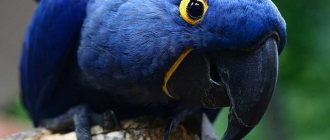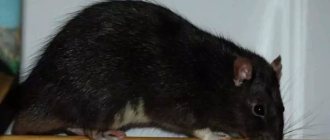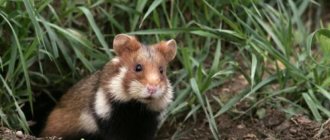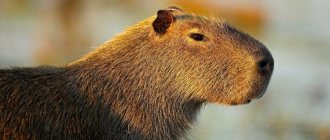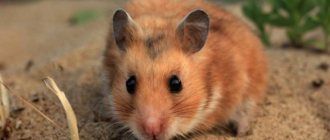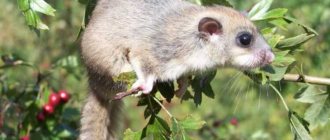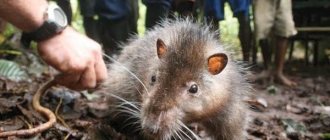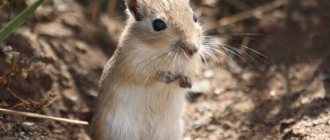Despite their small size, rodents are among the most feared creatures in the world. In a sense, this statement is stupid, because rats are much smaller in size than people. And yet, many people, especially women, are afraid of their appearance. And not in vain, because some rodents are actually worth fearing, since they carry viruses and diseases. There are several species of rodents that are large enough to be quite aggressive, at least enough to scare away a cat.
According to some scientists, rats could potentially grow if larger animals in their habitat go extinct. An often cited example is rats that "disembark" from ships on different islands only to breed and eventually become a key link in the local food chain.
According to one theory, rats could one day become as large as the world's largest South American rodent, the capybara, which weighs almost as much as most men. Before the capybara, the largest rodent in the world was the extinct species Josephoartegasia monesi. This animal lived during the Pliocene as well as the early Pleistocene and weighed about one ton. In addition, the authors of the above theory claim that rodents can increase in size as the environmental situation changes, and many mutations can occur. A parallel can be drawn with prehistoric mammals, which at one time were the size of rodents, but eventually evolved into horses, mammoths and rhinoceroses when the dinosaurs became extinct.
The largest rodent in North America is the beaver, whose body length can range from 29 to 35 inches, making it the second largest rodent in the world after the capybara. The beaver is a semi-aquatic animal with claws and a tail that is several feet long. Old beavers can weigh up to 110 pounds. The following is a list of rodents, including some of the largest rodents currently known to science.
Nutria
Nutria is a herbivorous, semi-aquatic, burrow-dwelling rodent native to South America. Resembling a giant rat, the typical nutria reaches between 28 and 42 inches in length. Adults weigh up to 37 pounds. At the beginning of the 19th century, most animals were driven out of their natural habitat. They began to be bred on farms in Argentina to make fur products. By the beginning of the last century, such fur farming had spread to North America and Eurasia, although the fur itself was not popular with traders. In the 1940s, these rodents caused a lot of trouble in Louisiana and Maryland: the animals escaped from local farms and their numbers began to grow rapidly in the wild. By the late 1950s, entire programs were initiated in Louisiana in which nutria were captured or destroyed.
Giant rats: myth or reality
Surely each of us has heard creepy stories about giant rats living in abandoned buildings and subways. There are a huge number of articles in newspapers and magazines, and people, reading such stories, believe in it and are really afraid that one day they will meet a mutant rat in person and will definitely take it to their home.
In fact, these are all unconfirmed myths, and the press uses them to attract readers and increase demand for their magazines and newspapers.
The largest rat in Russia is the pasyuk, its size does not exceed the size of an ordinary cat. Of course, their dimensions can be quite impressive, but this is not the result of a mutation, but simply an abundant diet. Pasyuk is definitely not a bloodthirsty monster and does not attack people. Therefore, you shouldn’t believe in mutant rodents, much less be afraid of them.
Castoroides or giant beaver
Castoroides, also known as the giant beaver, is an extinct North American rodent that lived during the Pleistocene. It weighed up to 275 pounds, had a body length of 6.2 to 7.2 feet in length, and it is unknown how much additional length the tail might have added to this figure. Castoroides are the largest of all beavers that have ever lived on our planet.
This species differed from modern ones in that the extinct animal had short hind legs, wide teeth, and a smaller brain than their modern counterparts. The first fossils of the Castoroides species were found in Ohio in the 1830s. Since then, remains of Castoroides have been found throughout America, from Alaska to Florida. Especially with many finds archaeologists have discovered in Indiana, Illinois and near the Great Lakes.
Possibility of attacks on people
Whether a rat can attack a person is a pressing question. Every year, hundreds of cases of rodents attacking people and leaving bites are recorded around the world.
The risk of being bitten increases in areas where the number of rodents exceeds acceptable limits. An increase in population provokes malnutrition and hunger. This is the main reason for the aggressive behavior of rodents. Rats can attack large mammals, birds, and humans in a hopeless situation:
- if a rodent is cornered, you need to protect your life;
- aggressive behavior is associated with an unbearable feeling of hunger;
- the animal has rabies.
Before jumping on a person, the animal takes a characteristic pose. It rises on its hind legs and a grin appears on its muzzle. Attacks with a jump. It can bite on the legs, arms, and grabs small children by the neck. A rat attacks a person with particular cruelty. An extremely dangerous situation when you have to defend yourself from several rodents.
Rat bites A rabid rat bites a person with particular aggressiveness
As the disease progresses, the sense of caution disappears, and the animal mindlessly rushes to attack all living beings. Outwardly, it is distinguished from a healthy rat by the presence of saliva that pours from its mouth, redness of the eyes
Viking rats
In 2014, an unusually large rat, more than 15 inches, appeared in the kitchen of the Bengtsson-Korsas family (Solna, Sweden). The rodent made passages in wood and concrete to get into the room. To destroy the pest, homeowners used the largest trap. The rat was so large that only its head could fit into the rat trap. She did not die immediately, but suffocated in her tunnel. The family first realized something was wrong when their cat, Enoch, became afraid to go into the kitchen.
Based on a number of studies and observations conducted in Europe, the UK and the USA, the appearance of so-called Viking rats may indicate abnormal development of individuals and various types of mutations. Experts who have monitored the rodents say they are twice the size of regular rats. In Dublin, exterminators caught a 24-inch rat in an apartment.
In addition, Viking rats are immune to poisons. Bromadiolone no longer works on them. According to a 2009 University of Huddersfield study, genetic mutation and immunity to poisons go hand in hand in this case, forcing specialists to create new, more effective poisonous drugs.
Chipmunk
The Asian chipmunk lives in Russia. Body length - up to 15 cm, gray or reddish fur with five dark stripes along the back. The tail is long and fluffy. The ears are round, without tufts. Has developed cheek pouches.
- Food: grains, plant parts, nuts, fruits, berries, fish, shellfish, insects, eggs of small birds. In captivity, it eats boiled meat, cottage cheese, bread, and dried fruits. Drinks a lot. A chipmunk will not drink dirty water. In nature it lives for 2-3 years, in captivity - up to 8 years. Makes supplies for the winter.
In captivity you need a large cage with a wheel and a house. In the house, the chipmunk makes a nest from cotton wool, rags, paper and leaves. Chipmunks are loners and do not get along well with each other. Among males, fights often end in death. Even animals of different sexes can fight.
Chipmunk Photo: pixabay.com
The domestic chipmunk eats from hands and allows itself to be petted, but will bite strongly if touched on the stomach or throat. In winter, the chipmunk sleeps, without leaving the house for days. During this period, his movements are sluggish and can be aggressive. In captivity it reproduces easily. One litter per year, 3-8 chipmunks.
You should not pull a chipmunk's tail: its skin is thin and can be easily torn off. It bites off the exposed tail, but loses maneuverability and dies.
The main feature of caring for an animal is to protect it from intestinal disorders. They very often lead to the death of a chipmunk. It does not tolerate heat and direct sunlight. Temperatures above 27 degrees can be fatal for him.
Mice of Gough Island
Situated in the South Atlantic, Gough Island has been overrun by approximately two million mice. Uninhabited areas have become an ideal breeding ground for them. It is noteworthy that rodents are twice as large as their counterparts living in the civilized world. Every year, 1.6 million petrel chicks are born on the island, and 1.2 million of them are eaten by mice.
Shearwaters are also eaten by black rats that have settled on the Tristan da Cunha archipelago, where, as on Gough Island, these rodents have no natural predators. Experts, in turn, continue to search for the best method for exterminating these pests, because even one surviving pregnant female can give birth to new rats that will multiply quickly. But scientists do not lose hope. In 2009, complete eradication of rats was achieved on Rat Island (Alaska), where rodents lived for 230 years.
They multiply at an incredible rate
Another type of movie monster is distinguished by the fact that it breeds a population of its own kind at an incredible speed. Usually these are alien creatures who intend to fill the entire Earth with themselves in record time. They may appear as shapeless amoebas made of flesh and teeth that reproduce by division, or as hideous winged monsters that lay eggs in human bodies. One thing is constant - they all multiply very quickly.
This group includes James Cameron's Aliens, John Carpenter's The Thing and... that's right, our rats.
One pair of rodents manages to give birth to up to 6,000 cubs in 2–3 years of their life. Less than three months pass before new offspring also begin to reproduce, and so on. Moreover, it is not customary for them for the younger generation to go to seek a better life in foreign lands. If there is enough food, they will not move until they flood the whole city.
By the way, many regions that skimped on pest control during the recession experienced a real rat outbreak. Britain's rat population now stands at around 80 million, up 200 percent from 2007. And even with all modern methods of rodent control, in New York there is at least one rat per person.
Josephoartigasia
An extinct species of South American rodents that lived during the early and late Pliocene. The rodent received its name in honor of a man named Jose Gervasio Artigas, who became the national hero of Uruguay. It was there that the remains of Josephoartigasia were found in 1981. In Montevideo, scientists discovered a 21-inch skull that was larger than that of a cow. Being the largest rodent of all time, Josephoartigasia lived in the forests of South America. The length of the body reached eight meters, and the weight was 2000 pounds. Most likely, the animals were herbivores, although it is possible that Josephoartigasia could not kill other animals in order to survive. Of the living rodents, Josephoartigasia resembles a large capybara in appearance.
2. Czech Republic: Prague rat
The Prague Ratdog is a diminutive creature, standing just 20cm tall, and is the smallest European dog breed. But their “mouse” size did not prevent them from becoming tireless and fearless hunters, and their name is translated from Czech as “little Pied Piper of Prague.” In the Middle Ages, nimble and fast rats saved cities from rodent invasions; they were given to kings, passed down by inheritance and depicted in paintings.
Smart, calm and obedient dogs have become excellent companions without losing their passion for hunting: they love long walks and enjoy chasing squirrels and pigeons.
Bosavi woolly rat
Scientists made one of the latest discoveries in the world of rodents in 2009, when a research team stumbled upon the remains of an animal in the crater of the extinct Bosavi volcano in Papua New Guinea. The team was given pointers by people from the local Kasua tribe. It is believed that the animal has never been seen by people before. Its body measures 32 inches long, making the rodent the largest living rat in the world. The status of a recent scientific discovery obliges scientists to give the animal an official name. This same crater was also the site of 40 other hitherto unknown species, including 16 amphibians, 3 fish, a gecko, a marsupial and several arachnids, none of which are believed to have been found in other parts of the world.
Although the Bosavi woolly rat is the largest living rat currently known to science, it is not the largest rat that has ever lived on the planet. The remains of a 13-pound rat that lived a thousand years ago were found in East Timor, Indonesia. The dense, inaccessible forests of eastern Indonesia have so far prevented further excavation, but it is possible that the remains of other extinct rodents may be found there.
1. Russia: Samoyed dog
The strange name of these northern dogs does not reflect their eating habits at all, but the self-name of their first owners, the peoples of the Samoyed group. The Nenets, Enets and Nganasans called themselves Samodi
, but the Russians in the old days pronounced this word as
samoyad
,
samoyeds
and even
samoyeds
. These tribes bred white dogs with dense thick hair and a unique “smile” for 3,000 years: Samoyeds helped them herd deer and hunt, sometimes even nursed children, and were never only sled dogs.
Often these friendly, sociable and very energetic creatures lived in tents with reindeer herders, and today they feel great in families.
In the Middle Ages, nimble and fast rats saved cities from rodent invasions; they were given to kings, passed down by inheritance and depicted in paintings.
Giant Hutia
This rodent lived on the island of Anguilla in the Caribbean more than 100,000 years ago. It was twice the size of adult humans and at least 1,000 times the size of modern rats. Known as Ambyrhiza, the extinct animal has an informal name: giant hutia. Excavations indicate that there were no mammals in Anguilla that could compete with the Hutia. After the end of the Ice Age, the water level became higher, and the rodent could not adapt to the new conditions.
Descendants of the Huti live on islands in the Caribbean today, but most are smaller, weighing just over five pounds. In Cuba they are called banana rats because of the shape of their droppings.
What threats do rats pose?
The fear is justified, since they do pose significant dangers to humans. It is no secret that they were the symbol of the plague in the past, since it was they who carried the pathogens of this disease. A yard dog that catches and eats a rat runs the risk of dying itself, since these animals adapt to poisons and carry them within themselves after eating the poisonous bait. They pose the following threats to humans:
- Carriers of infection. Contact with them even today can lead to plague or smallpox. People feel an instinctive fear of them, apparently embedded in genetic memory - almost every city dweller feels uncomfortable in their presence, even if they know nothing about the threat they pose;
- Dangerous beast with sharp teeth. These creatures are aggressive, and although due to their size they cannot immediately kill a person, they are quite capable of causing serious damage, killing young pets, or even biting a baby unable to defend itself;
- Psychological aspect. Even if, as a result of a rat bite, only a small and quickly healing wound remains, an attack by such animals can be traumatic for the psyche. In big cities, musophobia, the fear of rats, is widespread.
Another unobvious threat is the tendency of small, evil creatures to provoke man-made accidents. One of the most high-profile cases was the accident in Fukushima, but unlike the Chernobyl accident, where the accident occurred due to outdated equipment and the carelessness of the person himself, here the culprit was a rat. The investigation showed that a wire in the switchboard was chewed in a hard-to-reach place, resulting in a fire that led to the destruction of the reactor.
On the other hand, the danger is often exaggerated, but the truth is surrounded by epic rumors that provoke illusory fears
There are no huge mutant rats that appear in exclusion zones or sewers and can kill a person, and there is no evidence of such a thing, so we pay attention only to real facts.
Capybara
The world's largest rodent is the capybara, which lives throughout Brazil and neighboring countries. This barrel-shaped South American animal measures 3.5 to 4.4 feet in length and weighs 77 to 146 pounds. In Venezuela, capybara meat is served at the table. In the same region, fossils of prehistoric rodents that were much larger were found, including Phoberomys pattersoni (14 feet long), which scientists estimate weighed between 550 and 1,500 pounds.
Pros and cons of keeping rodents
pros
These include the following facts:
- inexpensive maintenance and minimum hassle;
- unpretentious care that any child can handle;
- these are very clean animals, so there will be no need for constant bathing;
- they do not make loud sounds and do not interfere with sleep;
- rodents are quite intelligent and easily amenable to simple training;
- There is nothing expensive that rodents eat: mainly special food, hay, vegetables, fruits, and various vitamins.
Minuses
The disadvantages include:
- many species do not live long - about 2-5 years, but the exceptions are chinchillas and rabbits, whose age can reach 12-15 years;
- the animal should not be allowed out of the cage if there is no one to look after it, otherwise the house will be a mess;
- the cage needs to be washed every day so that there is no strong smell in the apartment;
- small animals must be handled carefully, otherwise they may bite;
- can make sounds at night, since at this time of day they are most active.
This article talks about what types of domestic rodents are with photos and names.
Rodent sizes
Some of the largest living rodents can rival the size of dwarf cats and small dogs. What about the typical rodents that we find in buildings, parks, gardens, apartments all over the world? Below is a brief description of the average and maximum sizes of mice, rats and other rodents that can easily appear in your home or yard.
- House mouse. Body length is from 2.5 to 4 inches. The rodent has a tail that averages another four inches in length. As one of the most common house dwellers throughout North America, the animal can slip through holes as small as one-quarter of an inch.
- Deer mouse, also known as white mouse or field mouse. This rustic, brown-backed, white-bellied hantavirus carrier has a body length of four inches. The tail length averages 2.5 inches.
- Gray rat known as Rattus norvegicus. The animal with a six- to eight-inch tail is distributed throughout North America and other countries of the world, despite its Scandinavian nickname. The body can be 7 or 10 inches. While it may not be the largest rodent in North America, it is certainly one of the most commonly encountered.
- Roof Rat. This black rat is somewhat smaller than the previous one, measuring from six to eight inches in head and body length, although its tail is longer than its body, averaging seven to ten inches. Active throughout the year, the attic rat is primarily found in the South and along the West Coast of the United States.
- Forest hamsters. Threat to farmers and homeowners throughout the United States except New England and the Great Lakes. This dark gray animal typically has a seven-inch body and a seven-inch tail.
- Shrews. Characteristic features: long, pointed nose, light gray color. The rodent is common in yards and gardens throughout the United States. The length of the body is three to four inches.
- Voles. Farm and pasture pests love to eat plant roots. Body length can vary from three to nine inches, depending on the breed.
- Moles. Whenever a lawn or golf course turns into churned soil, there is a chance that moles have been there. Moles reach five to eight inches in length.
- Gophers. The animals reach from 5 to 12 inches in length.
Large wildlife rats
There are many types of rats, each with its own characteristics. We have selected the largest rats existing in the wild.
Kangaroo rat
Kangaroo rats can be found in the forests of South-East Australia. They are similar in appearance to ordinary rats, but have developed hind limbs, which is how they got their name. Another similarity between them and kangaroos is that they carry their babies in a pouch. The maximum length of their body is 40 centimeters.
These nocturnal animals live in burrows or nests, where they hide during daylight hours. They defend their territories very fiercely, but they are not aggressive towards all types of animals; they tolerate some and can live nearby.
They feed mainly on plant foods, less often on insects. In summer and autumn, their diet consists of mushrooms, they are full of essential proteins, but the most important source of energy for them is the bulbs, roots and seeds of plants. In winter they feed on the resin of trees or shrubs.
Female kangaroo rats reach sexual maturity at six months, and their mating season lasts all year round. Their pregnancy lasts only three weeks, after which the female mates again.
This species of rat is endangered because their habitats are being destroyed and they are also hunted by foxes.
Gambian hamster
They live in central Africa in a wide variety of conditions. They can be found both in deserts or forests, and in cities, where, settling, they harm human economies. They are nocturnal and cannot tolerate heat at all, so they build their nests in cool places, for example, tunnels or hollows.
They have poor eyesight, but this is compensated by their acute hearing. Omnivores, can eat any fruits, vegetables, nuts. They are able to independently obtain food from the age of one month. They hide food behind their cheeks, like hamsters.
Six months after birth, females reach sexual maturity. Reproduction occurs in the summer, the offspring are gestated for about a month, and 1–5 cubs are born. Only the female warms and feeds them, and the male does not take part in their upbringing.
The size of these animals is approximately 0.9 meters, and their weight is from 1 to 1.4 kg. This type of rat is capable of living in an enclosure or cage.
Do you know what is the largest wolf that has ever lived on the planet? Read about it on our website!
Turkestan rat
These rats inhabit the Central Asian mountains and foothills. Forest inhabitants are able to climb trees and dig holes, and can nest in trees and in holes. They are not a social species; they are not characterized by a group lifestyle. In nature they reproduce in the warm season.
The coat color is brown-gray with a reddish tint. The body length reaches 25 centimeters, and the tail length is 21 centimeters. These animals generally weigh 1–2 kilograms.
Bamboo rat
Bamboo rats are native to Asia and can be found in bamboo fields or cultivated agricultural land. They gravitate toward bamboo thickets, which makes up the bulk of their diet. They have very long claws, which they use to intensively dig deep and complex holes. The body length is 210–340 centimeters, and the tail is 6–7 centimeters; these animals weigh about 400 grams.
The meat of bamboo rats has been eaten by the Chinese for centuries; according to Chinese medicine, it is very healthy and has cleansing properties. But with the outbreak of Covid-19 in Wuhan, the export of bamboo rats to Chinese markets was banned as they began to be considered possible carriers of the coronavirus. It is unknown whether wild animals will return to markets.
Black rat
This type of rat is very common in temperate Europe, equatorial and southern Africa, North and South America. They are not picky when choosing a habitat; they can be either natural conditions or human buildings. In nature they prefer deciduous forests, gardens, shrubs, and in buildings they prefer walls, ceilings and attics. Very often found on sea vessels.
They are predominantly nocturnal. Most often they make nests in trees, sometimes in burrows. They exist in groups; there is an established hierarchy within the community. Each group has its own territory, which is protected from the invasion of other rats.
Reproductive age begins at 3–4 months, they are able to produce offspring all year round, pregnancy lasts approximately 3 weeks. They eat bread, grains, vegetables, meat. The body length is about 25 cm, and they weigh up to 350 grams.
Are you afraid of rats?
Yes
30.43%
No
69.57%
Voted: 23
Potoroo
Like kangaroo rats, they outwardly resemble a smaller copy of a kangaroo, even moving on their hind legs. They are active at night, feeding on insects and plants.
They grow up to 41 centimeters and weigh on average 1.5 kilograms.
cane rat
Cane rats, or bristly pigs, live in Africa, south of the Sahara. Their body length is 40–60 centimeters and their weight is 4–8 kilograms. They nest in holes near swamps where reeds grow, where they make paths for movement.
Animals become sexually mature at the age of 1 year. Usually the female gives birth to 2 litters per year, pregnancy lasts 3 months. Cane rat cubs become active immediately after birth.
The meat of these animals is considered a delicacy for the local population. It is sold in markets along with pork, beef and chicken.
Gray Pasyuk
The gray rat is found throughout the world except Antarctica and the Arctic. They are not picky when choosing a habitat, but prefer to settle on the shores of fresh water bodies, thanks to which they can swim well and dive quite deeply.
Under normal natural conditions, they dig holes and build nests in which they spend most of their time. This species is also well adapted for life in human buildings; they nest in basements, tunnels and even apartments.
Pasyuki are active in the dark, but living with people, they adapt to the regime of their owners. In nature, they live in groups in which males dominate, among them the strongest and largest is chosen, and he becomes the main one.
These rats are omnivores, but prefer to eat animal feed. Gray pasyuki give birth a lot; in nature, this mainly happens in the warm season. The number of newborn rat pups can reach 20 per year.
The maximum body length of pasyuk is 40 centimeters, and their weight is from 150 to 450 grams.
Protect your property from rodents of different shapes and sizes
While you're unlikely to encounter the world's largest rat or mouse in any English-speaking country, small pests can still find their way onto your property. Whether it's rats or mice invading your home or moles and gophers burrowing under your lawn, rodents can carry viruses and cause many other problems.
As soon as you see signs of presence, use Victor® traps and repellents. The Victor® catalog contains a wide selection of products that will quickly and efficiently solve all problems.
What diseases do rats carry?
To date, it has been proven that rats are carriers of more than 20 viruses, bacteria and protozoa that cause diseases in humans.
The most significant of them are:
- Plague - rats do not get it, but they carry its pathogen and are a natural reservoir for the plague bacillus. The plague bacillus itself is transferred from them to humans by fleas, which bite first rodents and then people;
- Endemic typhus, also called flea or rat typhus. Its main difference from other forms of typhus is precisely that its carriers, along with rats, are fleas (most other forms are carried by lice and ticks);
- Tetanus is a deadly disease that can develop after bites from almost any animal, and rats are no exception;
- Leptospirosis, also known as "rat disease". It is usually transmitted through contact or nutrition: it can be infected through food spoiled by rats (mainly through liquid dishes, milk and meat), water, as well as through direct contact with the animal (for example, when removing its body from a trap);
- Sodoku is a specific disease, sometimes also called rat disease. It is transmitted by rodent bites, and can also be contracted by cats or dogs that eat sick rats. After this, by the way, a cat or dog bite is also fraught with infection;
- Q fever - transmission of its pathogen occurs by inhalation, through inhalation of dust from the excrement of sick rats, or through spoiled food;
- Pseudotuberculosis, which is transmitted to humans through the nutritional route (mainly through products contaminated with rat excrement);
- Visceral leishmaniasis, or black fever, is the most severe form of leishmaniasis, which kills up to 50 thousand people annually in tropical regions. The causative agent is transferred from rats to humans by different types of mosquitoes;
- Cryptospiridiosis, which spreads through nutrition and is deadly for patients with immunodeficiencies;
- Toxoplasmosis is a relatively mild disease that poses a threat mainly to the fetus of an affected pregnant woman. It is most often transmitted through the nutritional route, through feces with which rats contaminate food;
- Creeping erythema, or erysipeloid, is a bacterial skin lesion. Most often it occurs among housewives when working with products contaminated with rat feces.
In addition, diseases carried by rats may be specific to different regions. Thus, in the USA, rats carry diseases such as Colorado tick fever and arenavirus fever, in South America - Chapare and Venezuelan hemorrhagic fevers, in Africa - Lassa fever (with a mortality rate of about 30%), in Siberia - Omsk hemorrhagic fever.
Also in Russia, rats settling on agricultural lands near human habitation become carriers and an important reservoir for the causative agent of Lyme disease. Partly from this source, ticks “feed”, which infect people with Lyme borreliosis.
It should be borne in mind that you can get many infections from rats, even if you don’t see, touch, or even know that they live nearby. A rat can scurry around unnoticed in a house or cellar, climb onto food at night, feed on it and stain it with its excrement. All you have to do is not prepare such products diligently enough, and bacteria from them will end up in the human digestive tract.
And fleas, swarming in the fur of rats, constantly scatter their eggs around the animals, and they themselves often leave the rodent’s body to find temporary shelter. If a rat gets into the living room for a while, there is a high probability that several parasites from its fur will remain there. And after a few days, when they get hungry, they will begin to bite people, possibly rewarding them with various pathogenic microbes.
This is exactly how, by the way, rats with fleas several centuries ago exterminated a third of the population of Europe...
Chinchilla
More recently, these animals were on the verge of extinction. They were killed for their beautiful fur. Now the situation has stabilized. Chinchillas continue to delight people with their irrepressible energy. During the day they behave calmly, and at night they are more active. For night hunting, nature has endowed them with large eyes.
Dormouse
Hazel Dormouse Photo: ru.wikipedia.org
Dormouse. Of the 4 Russian species, the hazel dormouse is suitable for home keeping. She is easily tamed, takes food from her hands and allows herself to be petted.
Sonya is a cute animal, similar to a squirrel, up to 9 cm long, weighing up to 27 g. Red color. Sonya spends most of her life in trees. Active from dusk until morning. The dormouse makes a nest from blades of grass, which it lines with bark and moss. Sometimes it occupies bird nests. In nature it lives for 2-3 years, in captivity - up to 6 years.
- Food: nuts, acorns, chestnuts, fruits, berries, young shoots, tree buds. Sometimes it drinks the eggs of small birds.
In winter it hibernates, moving into underground burrows. Doesn't stock up. Sonya is a loner. Dormouse should be kept in a cage with many shelves, perches and branches for climbing. In captivity, only the hazel dormouse produces offspring.


